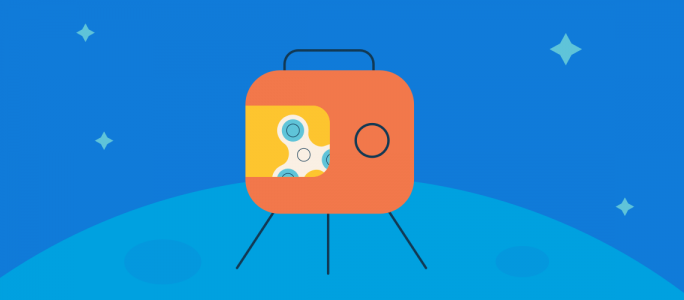Have you watched the recent SpaceX launch with your kids? Or maybe you celebrated Star Wars Day on May 4th? Then, why not take the chance to talk to your kids about the unexpected financial upsides (and downsides) associated with space exploration?
🚀 Space can really help us out on the ground
Plenty of hugely profitable, cool inventions came about thanks to space exploration. Did you know that the GPS trackers we use to help us drive our cars and find our way around developed out of the early days of the Space Race? Back in 1957, two American scientists realised they could pinpoint the world’s first space satellite (Sputnik 1, launched by the Russians), by carefully checking its radio signals.
The following year, they reversed the task and attempted to locate their own position on earth, via satellites. Their experiments led to the modern map finding tech in our phones!
Ask the kids:
What are your favourite inventions? Do you know how they were first made? What money-making invention would you like to see come out of space travel in the future? Holidays on Mars? Fruit farms from the moon? Maybe the next space mission will help us finally get those hover cars?

🏆 Space movies can turn old unwanted things, into valuable collectables
Did you know that the original lightsaber from the Star Wars film was made from a part of an old film camera? The movie’s special effects expert, John Stears, created Luke Skywalker’s original lightsaber from the cylindrical battery pack of an old camera flash. Stears bought this old camera part from a shop in London and glued on some other bits of metal to make them look space age. Those old camera parts wouldn’t have cost too much back in the 1970s, when the film was made, but today Star Wars super fans spend a lot of money on tracking down those old parts, and recreating lightsaber handles, just like the one Stears made!
Ask the kids:
Do you own anything that might go up in value? Some collectors pay a lot for old toys, and an old games console could be worth a lot in a few years time. Is there anything you think you might hang on to for a few years, just in case it becomes a valuable collectable?
👀 It pays to check your figures
If a kid screws up on a mathematics exam, they might lose out on a nice treat. However, they probably aren’t going to lose 125 million! That was the cost of NASA’s Mars Climate Orbiter spacecraft, which the space agency lost back in September 1999, after engineers mixed up metric and imperial measurements. Teams working on different parts of the craft confused two different units of force–pounds and newtons–which meant the Orbiter flew on the wrong course, and out of contact with the folks back on earth. That simple mix-up led to the whole mission’s failure.
Ask the kids:
What has been your most costly mistake? How about mum or dad? Crashing a car can cost a lot! Missing a plane can be expensive too. Are there ways to lower these risks?

😎 Space was once so costly, only governments could explore it. Now that’s changing
Add up the cost of the Apollo Space Programme–the project that enabled an astronaut to land on the moon, back in 1969–the amount, in today’s money, would be well over $150 billion. That’s more than most countries can afford to spend on such a project, never mind private companies. To begin with, only big, rich countries such as Russia, China and the USA could afford to explore space. However, more recently, other places, such as Japan and India, have launched satellites, while private companies such as Elon Musk’s SpaceX, have managed to find innovative ways to get into space more efficiently, by making reusable rockets, for example.
Ask the kids:
Can you think of big projects that only governments can really afford? Are there other things normal companies can take over sometimes? Remember, in the UK, TV, radio, telephones and postal deliveries were done by government organisations, but are now done by lots of different, private companies.
💸 Is there a currency for space?
You spend pounds in the UK, dollars in the US, and euros in Europe, so what do space tourists spend when they want to order a drink onout their way out of the atmosphere? Well, back in 2007, the British travel money company, Travelex, thought it had come up with the answer when it unveiled the Quasi Universal Intergalactic Denomination (QUID), a space currency. Fashioned from plastic, and containing a model of the Solar System, a single unit of the space money was supposedly worth £6.25, $12.5 dollars or EURO 8.68. Like many space missions, the QUID never really got off the launchpad. Most space tourism companies price their prospective trips in dollars, not QUID.
Ask the kids:
We usually spend different money when we travel overseas, but what does a place need for it to have its own money? A city? A government? An economy? How do people agree on what money to use when they’re outside any normal country, like when they’re at sea, or in an aeroplane?

🌛 You can’t buy a house on the moon
There aren’t police in space (yet!), but there are laws. Countries began signing up to the Outer Space Treaty back in the 1960s, and now most countries with a space program have agreed to abide by its laws. The treaty mainly covers the use of weapons in space, however, it also prevents countries from claiming the moon or other celestial bodies as their own. This rule should stop any very ambitious building firm from putting flats on the Moon or Mars, though it’s more likely to stop mining companies from digging extra-terrestrially.
Ask the kids:
Should we prevent people from owning bits of space? What would happen if we didn’t have this law? Are there any good things that the law might prevent too?
Did you like this? Then you can try our other articles, What the US Presidency teaches kids about money, What chocolate teaches kids about money, and What giving something up teaches kids about money.
Got any ideas or suggestions for what we cover next? Let us know at hello@roostermoney.com and it might get featured in a future blog!